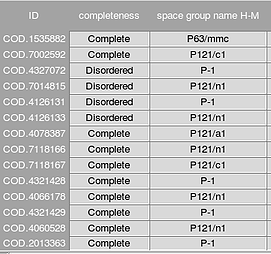MedeA Databases

Structure data and property data, both experimental and computed, provide vital information for materials formulation, preparation, characterization and lifetime performance. A common starting point for atomistic simulations is information about type and structure of a material. Often, this data is obtained from spectroscopic measurements such as x-ray powder diffraction (XRD) or neutron diffraction. With MedeA, the setup of atomistic models is straightforward and intuitive, as you can directly access experimental and calculated structure data gathered over decades.
MedeA InfoMaticA
MedeA InfoMaticA query engine provides rapid access to structure data and related properties from the most comprehensive crystallographic structural databases: Pearson, which is the crystal structures of the Linus Pauling File (LPF), the Inorganic Crystal Structure Database (ICSD), the NIST Crystal Database (NCD), and the Crystallography Open Database (COD). Collectively, these experimental databases contain well over 1.2 million entries. In addition, MedeA’s InfomaticA lets you build up your own, searchable structure database using computed properties.
MedeA ICSD
With MedeA ICSD, you have access to the structure database that is most frequently cited in literature. MedeA ICSD offers 215,000 records of experimental crystal structure information for non-organic compounds, including ceramics, minerals, and metallic systems. The integration of MedeA ICSD with the MedeA Builders, Property Modules, and Compute Engines makes ICSD an indispensable resource for any solid-state materials research and engineering project.
MedeA Pearson
MedeA Pearson encompasses more than 300,000 structure records of more than 95,000 different phases and is the world’s largest critically-evaluated, ‘non-organic database’. With a particular focus on alloys and intermetallics, MedeA Pearson provides exhaustive coverage of crystal structure data for inorganic compounds obtained from neutron diffraction and X-ray diffraction (XRD) powder diffraction measurements.
MedeA NCD
MedeA NCD contains chemical, physical, and crystallographic information on more than 237,000 inorganic and organic crystalline materials. The database includes reliable data across the entire range of solid state materials including minerals, inter-metallic phases, metals, alloys, drugs, antibiotics, and pesticides. In combination with MedeA InfoMaticA and other MedeA databases, MedeA NCD provides a useful backbone of crystal structure data for both organic and inorganic compounds.
MedeA COD GUI
With the MedeA COD GUI you have full access to more than 415,000 records of the COD structure data, and can fully leverage the rich COD content to perform atomistic simulations with MedeA. COD is the fastest growing open-access collection of crystal structures of organic, inorganic, metal-organic compounds and minerals, excluding biopolymers, and maintained by Villnius University.
MSI Phase Diagrams
MSI Eureka is the world’s leading and most comprehensive database for phase diagrams and related materials property data for metals, alloys, non-metals, and composites. The integration with MedeA makes MSI Phase Diagrams an indispensable resource for materials science and engineering.
Polymer Expert Analog Repeat-Unit Library (PEARL)
The PEARL database is employed by the MedeA Polymer Expert module to facilitate the exploration of polymer properties and de novo polymer design. This database contains more than 1.1 million repeat unit entries and efficiently spans synthesize-able repeat unit chemistry space.